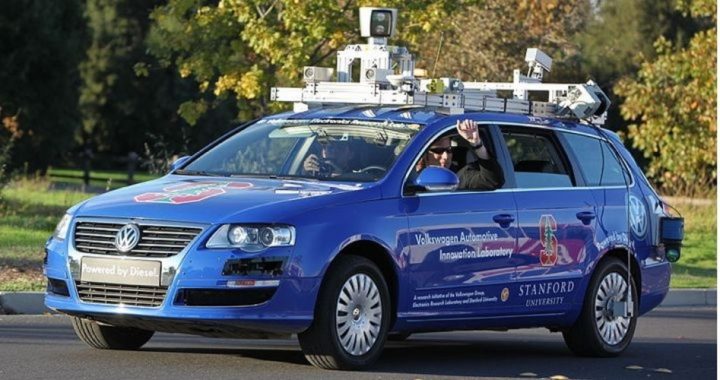
Whenever economic change takes place, there are those who ask: Where will those displaced find other work? In counting the costs involved as autonomous vehicles (i.e., driverless cars, self-driving cars, robotic cars, etc.) continue to revolutionize how people move, Wolf Richter of Wolf Street concluded that more than four million people will lose their jobs:
• Two million heavy truck and tractor-trailer over-the-road drivers;
• One and a half million delivery truck drivers;
• 250,000 taxi drivers and chauffeurs; and
• 500,000 Uber and other “ride-sharing” drivers.
He asked:
What are the 3.5 million professional and trained full-time drivers going to do? … What are the part-timers going to do? …
Over 4 million jobs is a big number. These people can’t easily switch to writing software. There’s no room for them in manufacturing. Even the fast-food sector is getting automated.
The simple but inadequate answer is: They’ll do what they’ve always done. They’ll find other work.
In 1800, the country was a three-mph society, limited by the speed of horses. The population of the United States was a little over five million. At present there are 325 million people in the country — certainly moving at much higher speeds, some even at 18,000 mph (astronauts!).
So, just how did that happen? Did those driving teams of horses just expire as the internal combustion engine came on the scene? What about the buggy whip makers? Did they just die off?
A better question Richter might have asked is this: What types of other work will these folks find as the AV revolution continues? Some no doubt will retire. Others will teach themselves how to write software. Still others will see opportunities where no one is presently looking.
The revolution is coming. It cannot be stopped. There is just too much economic advantage to stall it or delay it for long:
• Savings for major haulers will be massive: driverless trucks can operate around the clock and find their way to delivery points more efficiently than human drivers;
• Drivers will find themselves with an estimated three billion hours of free time while being moved to their destination, time that can be used to read, write, Skype, do research, even exercise;
• There will be higher speed limits, cutting travel time;
• Traffic deaths will drop, possibly precipitously, resulting in much lower insurance premiums;
• Fewer police will be needed as well as less highway signage;
• Less real estate wil be needed for parking garages;
• There will be far fewer vehicles on the roads; and
• They will be much cheaper to operate than at present.
• Oldsters will be able to remain independent at home longer, needing just to call up an AV to go shopping, go to lunch with friends, or take in a movie or a show.
It’s already happening in Pittsburgh. Uber has installed self-operating software in dozens of Ford Fusions for its “most loyal” customers. For the moment, those AVs also come with a driver/technician to take over if something goes wrong. But even that job will disappear as the software continues its inevitable improvement.
There will continue to be, in the words of economist Joseph Schumpeter, the “process of industrial mutation that incessantly revolutionizes the economic structure from within, incessantly destroying the old one, incessantly creating a new one.”
Such inevitability was lost on other naysayers in the past such as Edwin Drake, who, in 1859 asked: “Drill for oil? You mean drill into the ground to try to find oil? You’re crazy!”
Or Pierre Pachet in 1872, who said: “Louis Pasteur’s theory of germs is ridiculous fiction.” Or British surgeon John Eric Erickson, who in 1873 claimed, “The abdomen, the chest, and the brain will forever be shut from the intrusion of the wise and humane surgeon.”
Or even Lord Kelvin, president of the Royal Society, who stated flatly in 1895, “Heavier-than-air flying machines are impossible,” and Charles Duell, commissioner of the U.S. Patent Office, who, in 1899, claimed that “Everything that can be invented has been invented.”
And of course, what qualifies as the most expensive gaffe in history was Thomas Watson, chairman of IBM, who stated in 1943, “I think there is a world market for maybe five computers.”
An exercise in futility is that of predicting just where those displaced will wind up. First of all, the transition is taking place over time, not overnight. Second, the economy has so far failed to satisfy completely every need and every want of every soul on the planet. As long as those needs and wants remain unfulfilled, there will be an opportunity for someone to determine how to fill them. Certainly there will be an increasing need for software programmers and engineers as the AVs become more and more sophisticated. But there are vast unfilled needs in the healthcare industry, longevity centers, cancer treatment centers, in the entertainment field, in travel (sub- and super-sonic), for writers, for novelists, for filmmakers, for those exploring space, etc.
Richter is right to point out the inevitability of the AV revolution. He is just asking the wrong question about where those displaced will ultimately wind up.
A graduate of an Ivy League school and a former investment advisor, Bob is a regular contributor to The New American magazine and blogs frequently at LightFromTheRight.com, primarily on economics and politics. He can be reached at [email protected].
Related article:



